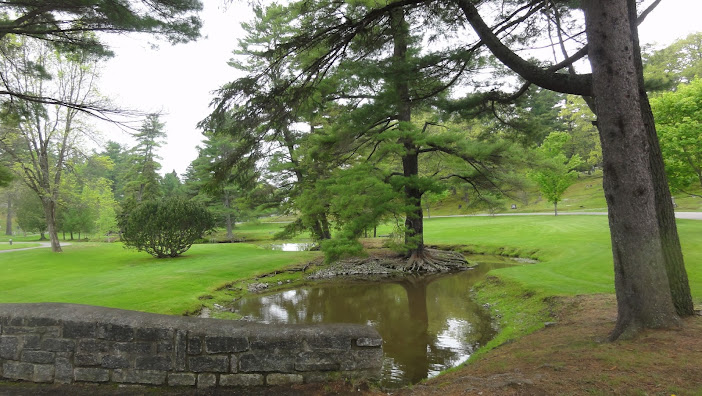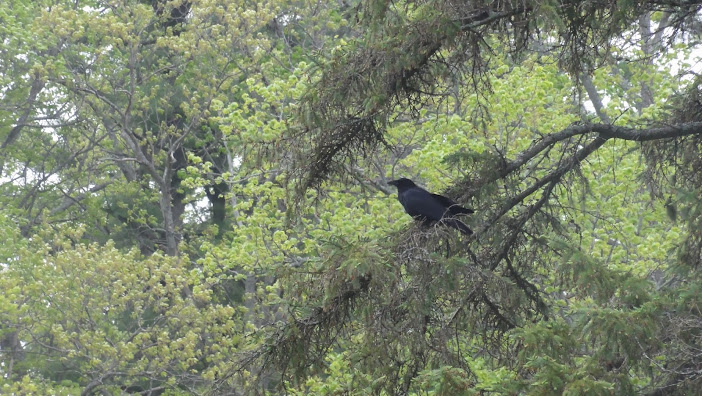 |
| Mount Hope Cemetery, Bangor, ME. circa 1877 |
Beneath those rugged Elms, that Yew-Tree's Shade,
Where heaves the Turf in many a mould'ring Heap,
Each in his narrow Cell for ever laid,
The rude Forefathers of the Hamlet sleep.
From
"Elegy Written in a Country Church-yard", Thomas Gray (1716-71)
For centuries, Christians have laid their loved ones to rest in, under and around their churches. Churchyards filled with graves remind worshipers and passersby alike of their mortal end. They help us focus every Sunday on primary issues, shooing away less important fancies of worldly pursuits.
Be that as it may, churchyards have presented problems for urban churches for lack of space. By the 1830s, cities were stuffed with mouldering heaps. The blog,
Victorian Gothic, records, "In the early 1800′s, New Yorkers looked with horror upon Trinity churchyard, which had become so densely packed with bodies that its burial mounds rose several yards above street level."
The advent of the
Victorian Era (1837-1901) heralded new inventions, new prosperity, social upheaval, new philosophies and new ideals.
David Charles Sloane details in
The Last Great Necessity: Cemeteries in American History, how the problem of overcrowded churchyards gave rise to a pleasing solution: the rural cemetery.
 |
| Mount Hope, 2nd garden cemetery in America. Bangor, ME |
Rural cemeteries were laid out as landscaped garden parks providing places for memorializing, reflectiing, strolling and even sight-seeing. All of which was right convenient for city-dwellers. While it might sound a bit weird to sight-see among the dead, I think of two cemeteries here in
historic Savannah, GA that draw thousands of visitors each year:
Bonaventure Cemetery and
Colonial Park Cemetery.
Mount Auburn Cemetery,
Boston, Massachusetts was the first of its kind in the United States, followed closely by
Mount Hope Cemetery,
Bangor, Maine.
Mount Hope's walking tour map shows how its plan nicely follows the contours of the landscape.
Mount Hope Cemetery may be home of the oldest Civil War monument in the country, Soldiers Monument, dedicated in 1864.
The Second Maine Infantry Regiment served in battles at Manassas and Fredericksburg, Virginia.
Mount Hope is also the resting place of a few more notables.
Hannibal Hamlin,
Abraham Lincoln's first Vice-President is buried there, as well as his children,
Sarah Hamlin Batchelder and
Charles Hamlin. Both are said to have witnessed
President Lincoln's assassination at Ford's Theater on April 14, 1865.
Al Brady, notorious gangster of the 1930s, is buried there. Brady began his life of crime in his native Indiana. He eventually made his way, along with gang members Clarence Lee Shaffer, Jr., James Dalhover, and Charles Geisking, to Bangor. Following the death of John Dillinger, Al Brady moved up to be the FBI's Public Enemy No. 1. He and his gang were on the run. Maine, with its vast forests, seemed like a good place to hide. Posing as hunters, they attempted to buy
Tommy guns at Dakin's Sporting Goods. It was their odd choice of hunting weapons that gave them away. When they returned to Dakin's to check on their order, the Brady Gang, except one, was gunned down by FBI agents. A plaque in a downtown Bangor sidewalk marks the spot.
Mount Hope was a site for the filming of the movie,
Pet Sematary, based on Stephen King's novel. Presently,
Stephen King is a resident of Bangor.
 |
| Ominous raven. Mount Hope Cemetery, Bangor, ME |
Mount Hope is a fine place to visit any time of year. Each season blankets it with a different covering and sets the stage for another mood. Follow the links below to see Mount Hope Cemetery in May.
A scene in Mount Hope Cemetery.
Office and Visitor Center.
Memorial Fort to the Grand Army of the Republic.
Bluet covered hillside. Mount Hope Cemetery.
Lilacs in bloom.
Webber Waiting Room.
Ubiquitous Arborvitae (Tree of Life).
Peirce Memorial to the 2nd Maine Regiment.
View of the Mount.
Return to
GoGardenNow.com.







